The OBD2 (On-Board Diagnostics II) port is a crucial component in modern vehicles, allowing mechanics and vehicle owners to access the car’s computer system for diagnostics and troubleshooting. If you own a 1996 Toyota Tacoma and are having trouble locating or using your OBD2 port, this guide is for you. We will explain where to find the OBD2 port on your 1996 Tacoma and provide troubleshooting steps if you encounter any issues connecting to it.
Locating the OBD2 Port on a 1996 Toyota Tacoma
For the 1996 Toyota Tacoma, the OBD2 port is typically located inside the cabin on the driver’s side. You will usually find it under the dashboard, near the steering column. It’s often in the vicinity of the fuse box and hood release lever.
To find it:
- Get into the driver’s seat of your 1996 Toyota Tacoma.
- Look under the dashboard below the steering wheel.
- Feel along the lower edge of the dashboard and you should locate a trapezoid-shaped, 16-pin connector. This is the OBD2 port.
It’s important to note that while the OBD2 standard was being implemented around 1996, some early OBD2 vehicles might have slightly different port locations or may exhibit some quirks in their implementation. However, for the 1996 Toyota Tacoma, the location described above is the standard one.
Troubleshooting a Non-Functioning OBD2 Port
If you’ve located the OBD2 port on your 1996 Toyota Tacoma but are experiencing issues connecting with a scan tool, here are some troubleshooting steps you can follow. These steps are based on common issues and solutions experienced by other vehicle owners.
1. Check Your Scan Tool and Cable
The first and simplest step is to ensure that the issue isn’t with your scan tool or its connecting cable.
- Try a different scan tool: If possible, test your OBD2 port with a different scan tool. You can try scanners at auto parts stores or repair shops. This will help you determine if the problem lies with your scan tool itself.
- Inspect the cable: Examine the cable of your scan tool for any damage, such as frayed wires or bent pins. A faulty cable can prevent proper communication with the OBD2 port.
2. Check the OBD Fuse
The OBD2 port is powered by a fuse, and a blown fuse is a common reason for a non-functional port.
- Locate the fuse box: For a 1996 Toyota Tacoma, the fuse box is typically located in the engine bay on the driver’s side. Refer to your owner’s manual for the exact location and fuse box diagram.
- Identify the OBD fuse: Check the fuse box diagram for the fuse related to the OBDII system or diagnostic port. It might be labeled as “OBD,” ” диагностика,” ” диагностический разъем,” or similar. In some Toyota models of this era, it might be linked to the “cig lighter” or “accessory” fuse.
- Inspect the fuse: Carefully remove the fuse and check if the wire inside is broken or burnt.
- Replace the fuse: If the fuse is blown, replace it with a new fuse of the same amperage. Always use the correct amperage fuse. Using a higher amperage fuse can cause further damage.
 Toyota-tacoma-mk2-fuse-box-engine-compartment-type-a-2012.jpg
Toyota-tacoma-mk2-fuse-box-engine-compartment-type-a-2012.jpg
3. Inspect the Wiring
While less common, wiring issues can also prevent the OBD2 port from working.
- Visual inspection: Check the wiring around the OBD2 port for any signs of damage, such as cuts, frays, or corrosion.
- Trace the wiring: If you are comfortable, you can try to trace the wiring from the OBD2 port back towards the fuse box and ECU (Engine Control Unit), looking for any breaks or loose connections. If you are not experienced with automotive electrical systems, it’s best to consult a professional.
4. Try a Powered OBD Scanner
Some OBD2 scanners are powered by the vehicle’s OBD2 port itself, while others have their own power source, such as batteries. In some cases, a non-powered scanner may fail to connect if there’s a slight power issue with the OBD2 port in the vehicle.
- Use a powered scanner: Try using an OBD2 scanner that has its own power source. These scanners can sometimes bypass minor power delivery issues from the vehicle’s port.
- Consider the anecdote: As in the original story, a powered scan tool was able to connect when a non-powered one failed. This suggests that in some cases, providing external power to the scan tool can resolve connectivity problems.
5. Disconnect and Reconnect the Battery
This is a simple step that can sometimes resolve temporary electrical glitches.
- Disconnect the negative battery terminal: Locate the negative terminal of your car battery (usually marked with a ‘-‘ sign) and disconnect the cable using a wrench.
- Wait for 30 seconds: Leave the battery disconnected for about 30 seconds.
- Reconnect the battery: Reconnect the negative battery cable securely.
- Retry the scan tool: After reconnecting the battery, try using your OBD2 scan tool again.
6. ECU Issues (Less Likely)
In rare cases, a malfunctioning ECU could be the cause of an OBD2 port not working. However, this is less likely than fuse or wiring issues.
- Consider professional diagnosis: If you have tried all the above steps and the OBD2 port still doesn’t work, the issue might be with the ECU. It’s recommended to take your 1996 Toyota Tacoma to a qualified mechanic for a professional diagnosis.
Conclusion
Having a functional OBD2 port is essential for diagnosing and maintaining your 1996 Toyota Tacoma. By following these steps, you should be able to locate your OBD2 port and troubleshoot common issues that might prevent it from working. Remember to start with the simplest solutions like checking the fuse and trying a different scan tool before moving on to more complex troubleshooting. If you are unsure or uncomfortable with any of these steps, always consult a professional mechanic.
